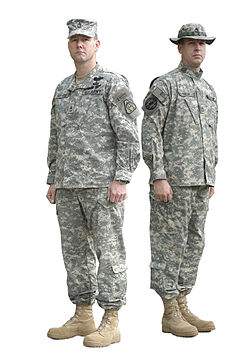
The Universal Camouflage Pattern
The Universal Camouflage Pattern (UCP), also referred to as ACUPAT (Army Combat Uniform PATtern) or Digital Camouflage ("digicam") is the military camouflage pattern currently in use in the US Army's Army Combat Uniform. The pattern was chosed after several laboratory and field tests that occured fron 2003 to 2004. Its pixelated pattern is a modification of the USMC's MARPAT camouflage and research into the Dual Texture camouflage. However, UCP was not well received and withdrawn after seven years in service.
Selection[]
Phase I[]
Initial patterns and colors[]
Three patterns were developed, called All Over Brush, Track, and Shadow/Line. For each pattern, there were four color combinations, which corresponded to a specific type of terrain, however, all four patterns used tan as their base color. The three remaining colors were green, brown, and black for the Woodland Pattern, dark tan, and brown for the Desert pattern, light grey, medium gray, and black for the urban pattern, and dark tan, light grey, and brown for the Desert/Urban pattern.
Test sites[]

Two soldiers wearing the Universal Camouflage Patterned ACU as well as UCP-patterned patrol cap (left) and boonie hat (right).
There were a total of fifteen evaluations, which took place at Fort Benning, Fort Polk, Fort Irwin, Fort Lewis, and Yakima, Washington. The camouflage patterns were then rated on their blending, brightness, contrast, and detection by US Army soldiers during the daytime, and also at night using night vision devices.
Elimination of Patterns[]
Following testing, the Shadow Line pattern was eliminated entirely, along with the urban and desert/urban patterns of All Over Brush. All four of the Track Patterns were accepted along with All Over Brush's woodland and desert patterns.
Phase II & III[]
The patterns were then modified and tested along a newly introduced "Contractor-Developed Mod" pattern, MultiCam. Near Infared Testing determined that black, grey, and tan were the only colors that gave acceptable performance.
Phase IV (system level)[]
All four remaining patterns, desert Brush, MultiCam, Woodland Track, and Urban Track were then tested alongside each other in urban, woodland, and desert environments.
Results[]
The desert Brush design received the best overall mean daytime visual rating. Contractor developed pattern receved the highest rating in woodland environments, but low ratings in desert and urban environments. Urban Track was generally the 3rd or 4th worst performer at each site, but was the best performer in nighttime environments, but low ratings in desert and urban environments. Natick rated the patterns from best to worst as: Desert Brush, Woodland Track Mod, Contractor-Developed Mod, and Urban Track.
Color selection[]
The color scheme of the Army Combat Uniform is composed of grey, tan, and sage green digital pattern. The pattern is noticeable for its elimination of the color black. Justification for the omission of black is that black is not a color commonly found in nature. Pure black, when viewed through night vision goggles, appears excessively dark and creates an undesirable high-contrast image.
Controversy[]

US Army soldiers in May 2006, wearing the UCP in Kunar province, Afghanistan.
The US Army reported to the media that the basis for the UCP was the Urban Track pattern, which had been modified through the removal of black from the pattern and pixelated. Why the Urban Track pattern was used, given that it received the poorest ratings in visual detection from the Natic Soldier Center's testing was unexplained. The US Army's public explanation of UCP's origin has been shown to be false, as visual comparisons of pattern samples have shown the UCP to be simply a re-colored version of the US Marine Corps MARPAT scheme, which in turn was based on the earlier Canadian CADPAT camouflage pattern. A more recent explanation provided by the development team is one of political interferance. Apparently they were advised to take the colors of the winning patttern and combine it with a pixelated pattern. This is unlikely to be a full explanation as the UCP color scheme bears little resemblance to any version of the winning "desert Brush" scheme.
The omission of black in the color palette has been the subject of much debate. Black is generally perceived in camouflage schemes as shadow and a degree of black, or an alternative dark color, invariable enhances a pattern's disruptive effect.
Some soldieers have reported that the pattern is less than ideal in most environments, particularly jungle and tropical terrains. As the US Army is currently involved in the Middle East, the uniform may have been biased towards the current operating environments.
When passed by the Senate, House of Representatives Bill 2346 required the Department of Defense to "take immendiate action to provide combat uniforms to personnel deployed to Afghanistan." The Army is currently evaluating alternative camouflage patterns to determine if this was a necessary action. in recent tests conducted by the US Army's Natick Soldier Center, results indicated that three other patterns did significantly better that UCP in desert and woodland environments. Currently four commercial submissions are being tested to replace the UCP for Army use.
Cancellation of the UCP and replacement[]
The US Army is cancelling the Universal Camouflage Pattern and considers the $5 billion program to be a colossal mistake. Army researchers are currently working on a new and better camouflage. The pattern has been determined to be very ineffective and has been widely unpopular amongst the rank and file for years. Four new patterns are being tested to give soldiers different patterns suitable for different environments, plus a single neutral pattern, to be used on more expensive body armor and other gear. The selection will involve hundreds of computer trials as well as on-the-ground testing at half a dozen locations around the world. The new camouflage patterns are scheduled to be put into field use by the end of 2013. There has been a timeline set for the fielding of new camouflage uniforms set by the Department of the Army.